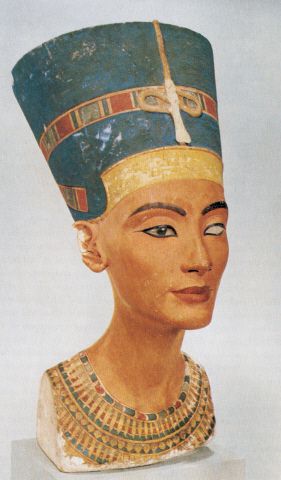
To order Hitler Sites ($55) click here
Egyptian Museum (Schloßstraße 70, U7 train to Richard Wagner Platz or U1 train to Sophie-Charlotte Platz).
 Dr.
James Simon (1851-1932), a Jewish Berlin merchant, financed a Deutsche
Orient-Gesellschaft expedition to Amarna, where in December 1912, Ludwig
Borchardt unearthed the limestone bust of Queen Nefertiti (ca 1350 BC), wife of
the Egyptian pharaoh Akhnaton (Amenhotep IV). Simon initially kept the bust in
his home, and then lent it to the Königliche Preußische Kunstsammlung in 1913.
On July 11, 1920, he donated Nefertiti to the Prussian State.
Dr.
James Simon (1851-1932), a Jewish Berlin merchant, financed a Deutsche
Orient-Gesellschaft expedition to Amarna, where in December 1912, Ludwig
Borchardt unearthed the limestone bust of Queen Nefertiti (ca 1350 BC), wife of
the Egyptian pharaoh Akhnaton (Amenhotep IV). Simon initially kept the bust in
his home, and then lent it to the Königliche Preußische Kunstsammlung in 1913.
On July 11, 1920, he donated Nefertiti to the Prussian State.
In 1933 the Egyptian government demanded the return of the Nefertiti bust, which was on display in the Kaiser Friedrich Museum. Hermann Göring suggested to Egyptian King Fu`ad I that the German government might not object. But Hitler had other plans. Through the ambassador to Egypt, Eberhard von Stohrer, Hitler informed the Egyptian government that he was an ardent fan of Nefertiti:
In the plans for the museum, there was to be an even larger hall of honor, with a bust of Hitler.I know this famous bust. I have viewed it and marveled at it many times. Nefertiti continually delights me. The bust is a unique masterpiece, an ornament, a true treasure!...Do you know what I’m going to do one day? I’m going to build a new Egyptian museum in Berlin. I dream of it. Inside I will build a chamber, crowned by a large dome. In the middle, this wonder, Nefertiti, will be enthroned. I will never relinquish the head of the Queen.
Hitler’s message to Egypt alarmed Göring, who spoke of an "exceptionally precarious situation." But Nefertiti has remained in Berlin, despite many subsequent Egyptian demands. In solitary grandeur, she is enshrined in her own room, illuminated by a spotlight. James Simon's descendants who survived the holocaust live in England and Beverly Hills, California.

